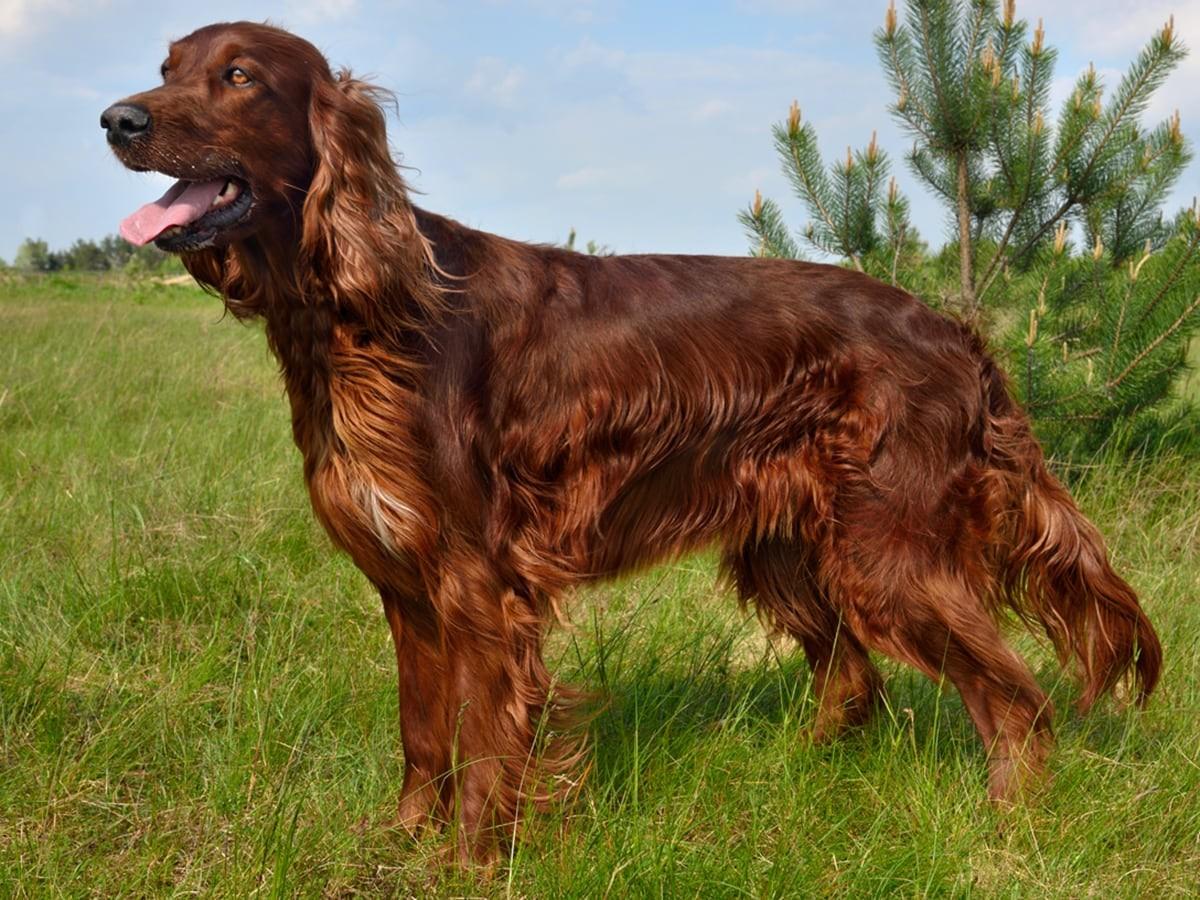
Irish Setter
The Irish Setter was originally bred as a hunting dog and has wagged its way into millions of hearts as a family pet. These dogs are known for their red-colored feathered fur and lean bodies. They love to be active and spend time with their owners playing or exercising.
Breed Profile
Height
25 – 27
Inches
Weight
60 – 70
Pounds
Life Span
11 – 15
Years
Health
health
Hip Dysplasia
What is it?
Abnormal growth of the hip joint can cause arthritis or leg lameness.
% of Irish Setters affected
12%
Clinical signs
Symptoms include leg lameness, limping, and refusal to move.
Treatment
There is a range of treatment options for canine Hip Dysplasia including medication, diet, exercise, and surgery.
Eligible vet bill
$2,000
*Hypothetical reimbursement examples illustrate reimbursement of an eligible vet bill at the noted reimbursement rate, assuming the annual deductible had already been satisfied and the annual coverage limit has not yet been met. Annual deductible, co-insurance, benefit and coverage limits, and exclusions may apply. Eligibility may vary. Visit https://spotpetinsurance.ca/sample-policy for full terms. For Canada enrollments only, reimbursement rate is based on the pet's age.
Personality
Friendly
Irish Setters are a very friendly breed that’s kind to everyone they meet.
Active
These dogs are highly active and will love daily exercise.
Affectionate
Irish Setters are known to be “Demonstrably Affectionate” and show love to all.
Lifetime Care
Coat
The Irish Setter has a double coat that feathers in areas like the chest, legs, body, tail, and ears.
Colors
The breed’s coloring is usually described as red or chestnut.
Hypoallergenic
Grooming
The Irish Setter needs frequent brushing to avoid matting.
Training
Training the Irish Setter is a breeze when you use positive reinforcement.
Irish Setter Breed Information
The Irish Setter was originally used as a gun dog or hunting dog. This is clearly shown in the dog’s slender body. This breed is most easily recognized by its red fur which feathers around its tail, ears, chest, legs, and body.
The breed is known for being extremely friendly. They will love to greet any new guest into your home. They’re also very active. Irish Setters will enjoy joining you for long walks, hikes, and outdoor activities. Also, they’re incredibly affectionate. They adore cuddles, pets, and general closeness with people.
Irish Setter: Introduction to the Breed
It’s no secret that bringing a new animal into your home as a pet is a big commitment. Not only could your life change dramatically, but it will change for years to come. That’s why it’s crucial for you to do your research on the pet you want and reflect on your lifestyle and family. Think about what attributes you want your new dog to have, and those that you would rather do without. Here are a few things you need to know about the Irish Setter’s temperament.
Irish Setters are generally:
Good with kids.
Bad with small animals.
Highly Active.
The Irish Setter is a friendly dog. This means that, typically, they’re great with kids. While older children will do much better with the dog thanks to its active lifestyle. It can also live harmoniously in a household with small kids.
Although it’s possible, it’s not recommended that the Irish Setter lives in a household with smaller pets such as hamsters, lizards, and sometimes cats. This is because of the dog’s hunting roots. They will find it hard to know the difference between friend and prey.
This breed is extremely active. They will love to play with their owners all day long. It’s important that the Irish Setter is given the opportunity to get its energy out every day. This can be accomplished with a long daily walk or specific exercise time each day. However, simply leaving the dog in the yard for hours on end may not be a good idea. This can lead to boredom behaviors like digging.
What are the Origins of the Irish Setter?
If you’re wondering about the history of the Irish Setter, look no further than the breed’s name! The dog comes from Ireland and the first records date back to the 18th century. Originally used as a gun dog the breed was bred to love running and hunting.
One of the most notable pop culture moments for the breed was Disney’s movie Big Red which was released in 1962. This brought the Irish Setter a lot of popularity and grew the breed tremendously.
What are the Risks for the Irish Setter?
Luckily, in general, the Irish Setter’s health is very good. However, no dog breed is without illness. For these dogs, one of the most common medical problems is Hip Dysplasia. This is when there is a problem with the hip joint that can lead to leg lameness and arthritis. It’s very painful for the dog. Thankfully, with surgery and the right medication, it can be managed, and your dog can lead a very happy and healthy life. Here are a few other medical issues to look out for.
Other Irish Setter health problems may include:
Cancer
Progressive Retinal Atrophy
Epilepsy
Entropion
Hypothyroidism
It should also be noted that there are many disorders and medical problems your dog may face that can be prevented. Working to avoid issues before they arise can help save you and your pup a lot of trouble in the long run.
One way to help prevent illness is to work with a responsible and reputable Irish Setter puppy breeder. The breeder will typically run genetic tests on the parent dogs to help ensure they don’t have any illness to pass on to the puppies. Another way is by keeping up to date with your dog’s regular care needs. This can include a healthy diet, exercise, and grooming practices.
Sources:
animalia-life.com
www.ortocanis.com
Wikipedia


